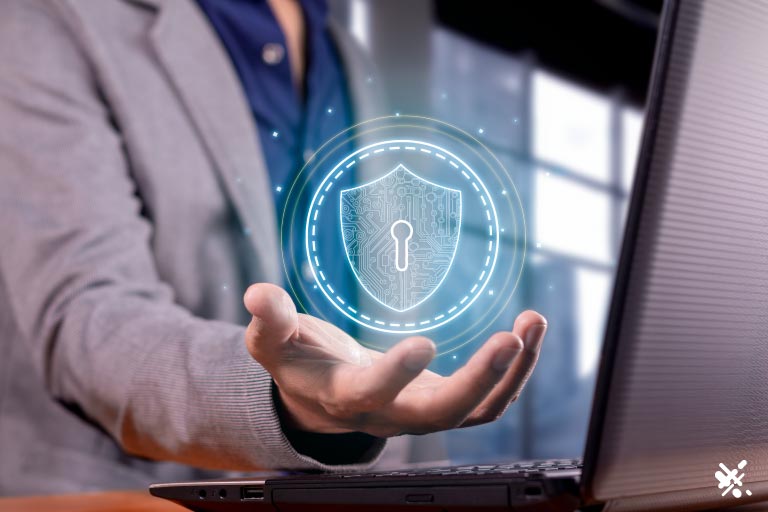Cyber attacks have become more common than ever as tech knowledge increases, especially in the hacker world. At this point, it’s crucial to explore how you can protect your business against phishing scams and any other cyber attacks. Business email compromise threatens, exploits, and can be financially disastrous to any business.
Over the last few years, you’ve undoubtedly noticed an uptick in cyberattack news reports. Many of these are high-profile attacks, such as with the password manager LastPass or, more recently, MGM Hotels and Casinos. But with every high-profile attack that makes headlines, millions of other attacks on small businesses go unreported.
But these smaller attacks can often be more disastrous for smaller businesses that don’t have the resources to weather the financial and reputational cost of a cyberattack or data breach.
Not only that, but businesses can acquire fines or penalties, not to mention possible civil litigation due to federal and state regulations, if there is a compromise on customer data. All of this means that protecting your business from cyberattacks and threats needs to be a top priority.
To help you protect your business, we’ll go over a common tactic that hackers use, known as phishing, so you can implement procedures and software tools to help mitigate this growing risk.

Understanding Threat Vectors
A threat vector is a pathway that a hacker or cybercriminal will use to enter your system without authorization or begin communication with someone who can give them access.
Hackers and scammers can employ various threat vectors to target a business, often by exploiting the business’s internet-connected systems. Any program or computer connected to the internet can be a possible vector for attack.
These types of attacks do require a high level of technical knowledge and effort, so they are less common but can still be very damaging. Updating software and using security best practices are often enough to mitigate these risks.
What Is A Phishing Attempt?
A phishing attempt is any email or communication sent under a false pretense to elicit a response that helps the attacker gain access to a system or sensitive account information, such as identity theft.
How Do Phishing Scams Work?
Phishing works by sending a fake email that tricks the recipient into an action they believe is legitimate. A simple example would be an email that claims to be from your bank and asks you to click a link and confirm your login and password or enter a credit card number.
The link will take you to the attacker’s fake website, which they have made to look legitimate. The victim then enters their login information, which turns it over to the hackers.
Phishing activities usually occur through email, although text message phishing is also growing in popularity and employs the same basic techniques as email but targets your mobile phone number.
Another common example is an email that appears to come from someone important or even from within your organization. It contains a document or file that it asks you to download and open.
This document or file will install malware once opened or some other malicious code that gives the attacker more access to that computer and possibly the company’s sensitive data.
What Type of Attack Is Phishing?
So, phishing is what kind of attack? Phishing is a social engineering attack. It doesn’t require much technical skill and relies more on human interaction. One of the most common forms of social engineering is via email scams because it’s easy to reach a large number of people relatively easily and at a very low cost.
A common phishing attack technique is to target individuals within a company or business. Phishers frequently target individuals within a company or business in a technique known as a social engineering attack, leveraging social norms like phone conversations or email communications.
What Does Phishing Mean in Email?
Phishing essentially means “fishing” because the hacker hopes to catch someone who replies to their fake or scam email. The term comes from a play on the spelling, which is common in the hacker community.
What Are Two Phishing Techniques?
Phishing techniques mostly fall under two categories.
Email Spam
The first is common email spam, sometimes referred to as spam phishing. Common phishing scams are based on a “numbers game” in which the attacker sends out as many fake emails as possible in the hopes they get someone to bite. In fact, attackers send 3.4 billion spam emails every single day. Generalized spam emails are easily spotted before most cause any harm.

Spear Phishing
The second most common category is spear phishing, which includes going after targeted individuals with specific information gained via social engineering. This can also include a technique known as whaling, which targets high-profile individuals or executives. Spear phishing attacks can often be the hardest to detect because they involve the most effort from the attacker.
Sophisticated Phishing Techniques
The above examples may seem like they would be easy to detect, and they can be. However, the examples were simplified, and attackers now use much more sophisticated phishing campaigns to create the illusion that their phishing email is real.
Below are some attack techniques to be aware of to avoid falling victim to a scam email.
Spoofed Sender
Hackers can make the email appear to come from anywhere, even when you check the “from” field in most common email programs such as Google. A glance at who sent the email can convince a lot of users that the email must be legit.
However, it’s important to understand that attackers can easily spoof or manipulate these fields.
Another common trick is using a domain (web address) very similar to the spoofed one. Hackers do this by changing one letter in the name or using a subdomain with the actual company name.
Users can create subdomains with any name, even trademarked or brand names. So, seeing the brand or corporate name in the sender’s domain can trick a user into thinking it is authentic.
Fake Sender
We mentioned how the attackers can spoof a sender’s domain. But they can also spoof even the sender’s personal identity.
With a more sophisticated attack, the hacker may already have gained access to other names within your address book or other employees at your company. Though they can do this through other hacking methods, sometimes just a simple scroll through publicly available profiles such as LinkedIn can give this information away.
The attacker will then create an email to appear to come from someone the victim knows, such as a manager, client, or vendor. This type of spear phishing targets that specific individual via information gained through other social engineering methods.
Fake Graphics and Layouts
Hackers will often use real emails from the company they are spoofing to create the phishing emails they send. This means the logos and overall layout may look identical to any real email a legitimate company sends.
It’s very easy to create a fake email that looks identical to a real email that a company would send. So, just because it looks legitimate and has the right logo doesn’t prove the email’s validity.
Urgency
Another thing to be aware of is if the email creates a sense of urgency. Urgency might look like a notification that your account has been compromised or some action must be taken immediately to prevent harm.
This causes the recipient to let down their guard since they think they have to act immediately without giving it proper thought. A sense of urgency can often be the sign of a phishing email if it’s asking for sensitive information or asking you to download something.
How To Protect Your Business Against Phishing Scams
There are some best practices to help your business mitigate the risk of email scams and phishing attacks. Below, we’ll cover the most important steps to protect your business against phishing scams and keep your data safe.
Malware and Antivirus Software
Installing anti-malware and antivirus software on your systems is one of the fastest and easiest ways to protect your business against phishing scams. This is a relatively small investment compared to the damage that may be prevented. The resulting ROI is substantial.
You can also set most antivirus programs to auto-update. So many of these programs require very little maintenance, if any. This makes them easy even for small businesses that may not have the resources to maintain software otherwise.

Keep All Software Updated
Up-to-date software is critical in protecting your business against phishing scams. Yet, businesses often overlook this area over time due to other more pressing issues.
Most software becomes vulnerable at some point in time when hackers find security issues. Reputable software companies are generally fast to release security patches to close these holes, but businesses must have a procedure to install updates when they become available.
Similar to antivirus software, many business apps have the option to auto-update when it comes to security patches. Make sure to enable that option on all your apps that support it.
For larger organizations, a remote monitoring and managing (RMM) solution can help you manage all of your business computers from one location and set up regular updates to ensure they all stay current.
Have A Robust Backup Plan
As a business, the best way to protect your business against phishing scams is having cybersecurity prevention tools in place. However, even with the best policies, a breach can still occur. This is why every business needs a robust backup plan.
To recover data from a time before compromise, you must maintain continuous and rolling backups of various systems.
Depending on the size of your business, you may want to consider a service provider specializing in backups. These services use the latest protocols and best practices to ensure your data is safe should it ever need restoration.
Remote Workers And Phishing Risks
One recent change that many businesses have had to deal with is the rapid adoption of remote work. While remote work has many benefits, the speed at which businesses have adopted it has left many vulnerable from a security standpoint.
With workers accessing your business systems from all over and from various devices, it’s much harder to maintain security and protect your business against phishing scams.
Below are some helpful tips to keep remote workers and your business safe from phishing attacks.
Use Multi-Factor Authorization (MFA)
Workers should protect their accounts with multi-factor authorization (MFA) when possible. In essence, MFA requires a second confirmation and a password. Free services such as Authy or Google Authenticator make this relatively easy and inexpensive for users and businesses to implement.
These apps work by sending a one-time token to the user via the app when they attempt to log in to a website. Once logged in, the token no longer works. Even if a password is compromised, hackers typically cannot gain access to a compromised account if it employs MFA.
Education And Awareness
Some remote workers may not fully understand the risks of phishing attacks or even the signs. This means that businesses need to educate their employees on what to look for and how to mitigate the risks to protect their business against phishing scams.
Software and other tools can drastically help with reducing phishing risks, but the first line of defense is having knowledgeable employees.
Make sure your workers are aware of the following risks:
Spoofing
The sender’s email account can be easily faked. Instruct employees that if they receive a link or attachment that they are not expecting, they confirm it by phone, text, or email the original sender. Don’t reply to the suspected spoofed email.
Emergencies or Urgency
Employees should know that emails that claim to be about an emergency or urgent matters that need immediate attention may be a sign of a phishing email. Make sure they never respond with personal information until they confirm the message.
Point of Contact
If you have an IT department or staff, ensure employees know they are free to contact an IT member with any questions about a suspicious email. Many employees are nervous to ask about such things, so make sure they understand there is no reason to hesitate if an employee has questions about an email’s validity.
Report Any Suspected Breach
If an employee falls victim to a phishing attack, ensure they know to contact IT personnel immediately. Quick action can limit the damage once a breach occurs. But a breach that goes undetected because it was not reported can be much more damaging.

Use Unique Passwords and a Password Manager
Instruct employees to always use proper passwords and to not share passwords across different systems. A password manager can also help with this. Secure passwords with proper MFA can generally stop most phishing attacks, even if the employee clicks on a malicious link.
Use Bookmarked URLs, Not Links
When quickly glancing at a link in an email, it may look legitimate, but it may be just one letter or number off and will take the user to a malicious website. Have employees habitually use bookmarked URLs in their web browsers when visiting common websites or services.
How IT Departments Can Be Targets For Phishing Attacks
Employees are often the targets of email scams and phishing attempts, but that doesn’t mean IT departments are immune from these threats. It is not uncommon for IT departments to receive phishing emails. IT departments are specifically targeted due to their knowledge and access to critical systems.
In these cases, attackers send emails from accounts meant to look like company employees. Using social engineering techniques like scraping LinkedIn or using email prospecting tools meant for sales leads, hackers can easily find the identity and email addresses of employees.
Then, they pretend to be these employees and contact the IT department to ask for password resets or other services that help them gain access to various systems.
For larger businesses, your IT department needs to be aware of these issues and use the same precautions as the rest of the employees when responding to emails.
To help fight email scams like this, your IT department should be using a ticket system or helpdesk application. If an employee needs assistance, they should open a ticket. This helps to confirm the identity of the user.
Emails and even phone calls to the IT department can easily be faked, giving a hacker immediate access without even defeating any traditional security measures.
Final Tips To Prevent Email Scams
Phishing attempts and email scams are both on the rise, becoming more sophisticated every day. What used to be easy-to-spot spam emails with poor grammar are now carefully crafted and targeted emails that look authentic.
However, stopping these attempts often comes down to basic security protocols that should be the foundation of any business of any size.
These foundations include using security software such as antivirus/anti-malware that is always up to date.
Next, ensure that you update all software for security as soon as patches and security fixes become available. If possible, use RMM software to keep everything up to date across your whole business network.
Finally, education is key for keeping employees on guard. Ensure your employees know what to look out for and that they have someone they can contact within your organization if they ever suspect an email is fraudulent.
By following these foundations of security best practices, businesses should be able to mitigate the risks from the ever-growing risk that phishing and email scams pose.
ECS Payments is a trusted leader in payment processing for businesses around the world. Our secure and innovative payment solutions allow businesses to reduce costs and improve customer experience. Contact ECS Payments today to learn more about our payment solutions that can take your business to the next level.
